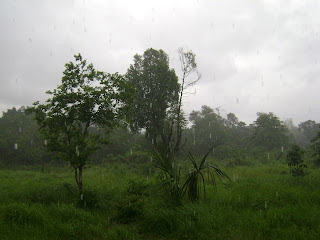11: members of the Sendai JETs Global Village team
8: Americans
1: Canadian
1: Kiwi
1: Japanese
5: girls
6: boys
2: number of teams we were asked to divide into, as 5-6 is the ideal number for most of the tasks we were assigned to.
8: age of the Habitat Village in Puerto Princesa, Palawan
128: number of homes in the Village
400: goal number of homes for the Village

>5: U.S. dollars per month required for rent. Rent can also be paid through labor, most frequently brick-making; there were two adults and three adolescent boys who spend most of their days making bricks -- when the foreigners aren’t taking up all their supplies of molds and shovels.
7+: hours each day during which the Village has no electricity (8 am to 3 pm). There are also unscheduled blackouts and brownouts (wherein there is electricity, but not enough to go around so some people don’t get any) relatively frequently. No power means no power tools, so everything from mixing concrete to pounding gravel into molds to make bricks is done by hand. There is also no running water, so all the water we used and the villagers drink either falls from the sky or is hauled up from the creek.
5: large piles of gravel that had been hauled up from the nearby creek, one in front of each house. The same gravel was used for everything: as-is for basic concrete, sifted for mortar, mixed with rocks (the rocks sifted out during the pre-mortar preparations) for the floor, and as a playground by the children.
10: number of bags of gravel, per one bag of cement mix, required for mortar and flooring.
6-8: number of buckets of water required for flooring, depending on how recently it rained.
30: minutes to mix a batch of concrete, pass it in buckets into the house, and spread it into a nice smooth floor.
8: batches of concrete required to complete a floor.
3: floors completed during the first three days.
80: shovelfuls of gravel, per one bag of cement mix, required for bricks.
113: bricks completed by 8 Sendai JET team members (5 in the morning and 8 in the afternoon) over the course of a 6-hour day. Not counting the ones that fell apart when we tried to remove them from the molds.
150: bricks completed in eight hours by one homeowner, who makes bricks to pay his rent.
3: number of wheelbarrows on site, used to move the bricks from the drying area to the under-construction house.
5-7: number of bricks that can be placed in each wheelbarrow at a time.
25ish: hours that one team or the other spent hauling bricks from one place to another.
1.5: depth, in meters, of the hole needed for sewage. (It was then to be covered with a concrete lid that would keep out the smell -- and, presumably, keep everyone from falling in a la Slumdog Millionaire.)

>.5: depth, in meters, of The Hole at the end of those 4 hours.
3: meals provided on-site, by women whose cooking, I think, was their rent contribution to the month. It was lunch and two snack breaks (merendas) -- but they provided enough food for them each to be a meal in themselves.
4: approximate number of mangoes I ate every day. Not counting however many go into a mango smoothie, which I drank basically every dinner if they were on the menu.
2: grand total of Tagalog phrases learned. Salamat po = Thank you. Magandan umaga = Good morning.
3.5: hours required for the children to overcome their shyness; ie, until lunch the first day. After that, we all had lots (and lots) of new friends. Their favorite game was to learn all our names, then shout them one by one to see how long it would take us to turn and wave. This game was especially fun if they were up in a tree or hiding behind something.
2: long-suffering souls provided to keep an eye on our stuff during the day and keep an eye on us at whatever shopping outlet/dangerous part of town we decided to explore after work.
3: number of days on which we decided to delay showers so as to explore and/or purchase necessities like non-Japanese sunscreen (ie, sunscreen that might have a chance of working) and aloe (because Japanese sunscreen doesn't work).
∞: stares intercepted as we wandered around splattered in an aromatic mixture of sweat, rain, concrete, and mud. Plus the pricelessly polite comment from a store clerk: “Why are you wet, ma’am?”
2: (air-conditioned) vans and drivers provided to transport us to the Village and then back to the hotel -- and to whichever restaurant we chose for dinner.
90: preferred speed, in kph, of Roy and Lolo, our drivers.
30: average speed of a tricycle on the National Highway.

24: other vehicles passed during the drive on Friday.
60: minutes required to drive from the hotel to the Village.
45: minutes required when we were running late on Monday morning. We tried very hard to never be late again.
2001: average year of release of the American pop songs we heard on the radio.
1986?: year of release of the CD of Filipino favorites they unearthed to play for us whenever there was electricity. Just whistle while you work -- or, rather, sing along to songs whose words you will soon memorize even though they aren’t in your language. I still have “Oomba Papalicious” running through my head.
5: homes dedicated and occupied by their new owners in a ceremony on Friday afternoon.








No comments:
Post a Comment